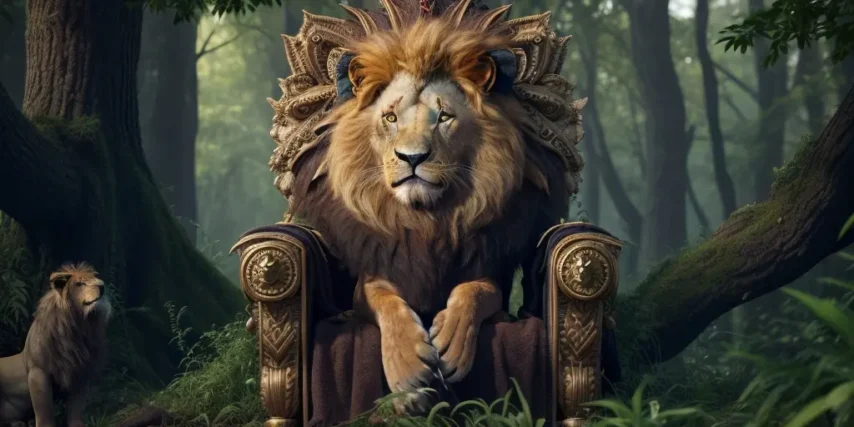The Majestic Monarch: Unraveling the Myth Behind the Lion as the “King of the Jungle”
In the vast and enchanting realm of the animal kingdom, few creatures command as much awe, respect, and fascination as the regal lion. Often referred to as the “King of the Jungle,” this majestic feline has captured the imaginations of people across cultures and generations. But why is the lion bestowed with such a lofty title, and what lies beneath the surface of this symbolic association? In this exploration, we delve into the historical, cultural, and biological aspects that have crowned the lion as the undisputed monarch of the wild.
The Jungle Misnomer:
To begin with, the curious case of the lion being dubbed the “King of the Jungle” is riddled with a bit of irony. Lions, in reality, do not inhabit jungles; rather, their natural habitat consists of open grasslands, savannas, and plains. This misnomer may have originated from early misinterpretations or perhaps from the mystique associated with jungles, which are often considered wild and mysterious. Despite this geographical inaccuracy, the metaphorical significance of the title is what truly captures the essence of the lion’s reign.

Historical and Cultural Significance:
The lion’s royal association dates back centuries and has been deeply ingrained in human history and culture. In ancient civilizations, the lion was frequently depicted as a symbol of strength, courage, and nobility. The Egyptians, for instance, revered lions as sacred beings, often portraying them in statues and hieroglyphs to represent divine power. In Greek mythology, the Nemean Lion was a formidable creature that Hercules had to overcome as part of his Twelve Labors, solidifying the lion’s status as a symbol of Herculean strength.
Furthermore, the lion’s historical presence as a symbol of royalty is evident in various cultures. European monarchs, such as Richard the Lionheart, adopted the lion as a symbol of their regal authority, associating themselves with the majestic traits attributed to this formidable feline. This cultural entwinement has perpetuated the lion’s image as a symbol of power, leadership, and dominance.
Biological Foundations of Royalty:
Beyond the symbolic realm, the lion’s biological attributes contribute significantly to its reputation as the “King of the Jungle.” Panthera leo, the scientific name for lions, possesses physical characteristics that underscore their dominance within the animal kingdom. The male lion, with its magnificent mane, not only exudes a regal aura but also serves as a visual representation of strength and virility.
In the wild, lions exhibit remarkable social structures that further reinforce their monarchical status. Living in prides, lions showcase a cooperative and strategic approach to hunting and protecting their territory. The collaborative nature of prides, with a dominant male at the helm, aligns with the societal structures often associated with monarchy and rule.

The Roar of Authority:
One cannot discuss the lion’s claim to royalty without acknowledging its formidable vocal prowess. The lion’s roar, resonating across the savannah, serves as a declaration of dominance and territorial ownership. The sheer power and depth of the roar are not only spine-chilling but also carry overtones of authority, establishing the lion as a ruler of its domain.
The roar of a lion can be heard for miles, effectively communicating messages to potential rivals and members of the pride. This vocal command, coupled with the lion’s imposing physical presence, further cements its status as a sovereign force in the animal kingdom.
Cultural References in Popular Media:
The lion’s reign as the “King of the Jungle” has transcended ancient cultures and found its way into contemporary popular media. Perhaps most notably, Disney’s “The Lion King” has immortalized the lion’s royal imagery in the hearts and minds of audiences worldwide. The character of Simba, the young lion who evolves into a wise and benevolent king, embodies the enduring appeal of lions as symbols of leadership and nobility.
Moreover, the lion’s association with heraldic symbols, flags, and emblems of various nations and organizations reflects its enduring presence as a regal emblem. From the national emblem of India to the iconic lions guarding the Trafalgar Square in London, these representations underscore the lion’s enduring significance in the collective human consciousness.
Conservation and the Crowned Kings:
While the lion’s symbolic monarchy prevails, it is essential to address the stark reality faced by these magnificent creatures in the modern world. Lions, once abundant across Africa and parts of Asia, now face threats such as habitat loss, poaching, and human-wildlife conflict. Conservation efforts are crucial to ensuring the survival of these regal beings and preserving the ecological balance of their habitats.

Organizations and initiatives dedicated to lion conservation work tirelessly to protect these apex predators. Efforts range from establishing protected areas and wildlife corridors to raising awareness about the importance of coexistence between humans and lions. By supporting these initiatives, we can contribute to securing the legacy of the true “Kings of the Wild.”
In the intricate tapestry of nature, the lion stands as a living symbol of strength, courage, and majesty. While the moniker “King of the Jungle” may be geographically inaccurate, its metaphorical resonance encapsulates the lion’s enduring impact on human culture and history. From ancient civilizations to modern media, the lion’s regal image persists, a testament to its timeless allure.
As we navigate the complexities of coexistence with the natural world, let us not forget the responsibility we bear in preserving the legacy of these crowned kings. Through conservation efforts, awareness, and appreciation for the lion’s symbolic significance, we can ensure that the roar of the “King of the Jungle” continues to echo across the savannah, a powerful reminder of the wild’s enduring royalty.







